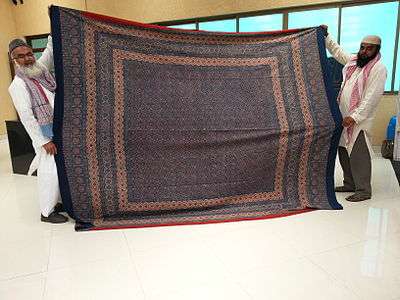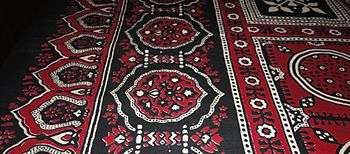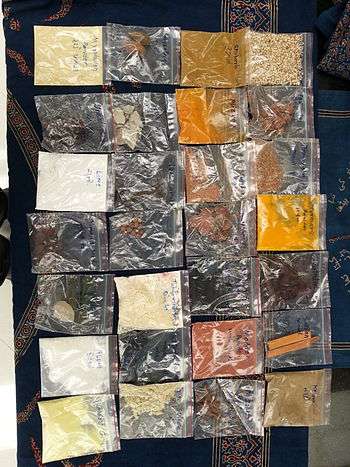Ajrak


Ajrak (Sindhi: اجرڪ) is a name given to a unique form of blockprinted shawls and tiles found in Sindh, Pakistan; Kutch, Gujarat; and Barmer, Rajasthan in India. These shawls display special designs and patterns made using block printing by stamps. Common colours used while making these patterns may include but are not limited to blue, red, black, yellow and green. Over the years, ajraks have become a symbol of the Sindhi culture and traditions.[1]
History
Early human settlements in the region which is now the province Sindh in Pakistan along the Indus River found a way of cultivating and using Gossypium arboreum commonly known as tree cotton to make clothes for themselves. These civilizations are thought to have mastered the art of making cotton fabrics.
A bust of a priest-king excavated at Mohenjo-daro, currently in the National Museum of Pakistan, shows him draped over one shoulder in a piece of cloth that resembles an ajrak. Of special note are the trefoil pattern etched on the person's garment interspersed with small circles, the interiors of which were filled with a red pigment. This symbol illustrates what is believed to be an edifice depicting the fusion of the three sun-disks of the gods of the sun, water and the earth. Excavations elsewhere in the Old World around Mesopotamia have yielded similar patterns appearing on various objects, most notably on the royal couch of Tutankhamen. Similar patterns appear in recent ajrak prints.
The level of geometry on the garment comes from the usage of a method of printing called woodblock printing in which prints were transferred from geometric shapes etched on the wooden blocks by pressing them hard on the fabric. Block printing is thought to have been first used in ancient China, at least as far as movable type is concerned. On its way through the populous regions of the Indus Valley, this technique of fabric printing was adopted at Mohenjo-daro.
The tradition still prevails centuries later, and people still use the same methods of production that were used in the earlier days to create an ajrak. The garment has become an essential part of the Sindhi culture and apparel of Sindhis. Men use it as a turban, a cummerbund or wind it around their shoulders or simply drape it over one shoulder. Women use it as a dupatta or a shawl and sometimes as a makeshift swing for children. Ajraks are usually about 2.5 to 3-meters long, patterned in intense colours predominantly rich crimson or a deep indigo with some white and black used sparingly to give definition to the geometric symmetry in design.
Ajraks are made all over Sindh, especially in Matiari, Hala, Bhit Shah, Moro, Sukkur, Kandyaro, Hyderabad, and many cities of Upper Sindh and Lower Sindh.
The ajrak is an integral part of Sindhi culture and Sindhi nationalism. Its usage is evident at all levels of society, and is held in high esteem, with the utmost respect given to it. According to Sindhi traditions, ajraks are often presented as gifts of hospitality to guests and presented to the person who is utterly respectable. They are also worn on festive occasions such as weddings and cultural events. Many prominent politicians from Sindh publicly adorn Ajrak, including the deceased former Pakistani Prime Minister, Benazir Bhutto.
Natural Dyes
Ajrak craft products are made with natural dyes. The entire production of the products include both vegetable dyes and mineral dyes. Indigo is key dye.

See also
References
- ↑ Bilgrami, Noorjehan (March 20, 2009). Sindh Jo Ajrak. Department of Culture and Tourism, Government of Sindh,1990. p. 177. ISBN 9789698100001. Retrieved 28 August 2015.